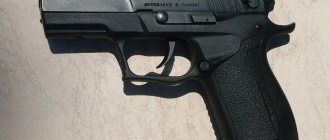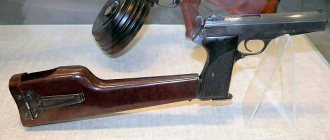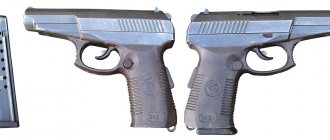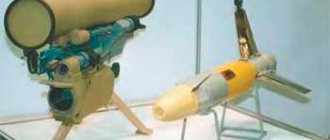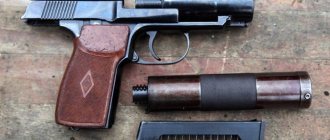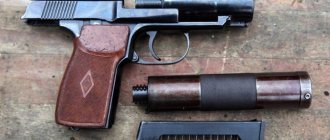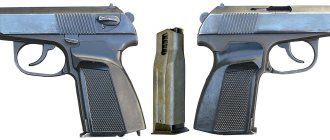The PB 6P9 silent pistol became one of the results of weapons programs that in the 1970s and 1980s in the Soviet Union began to rapidly develop silent weapons for a variety of special forces. The PB is capable of silent fire at a distance of up to 20 - 30 meters. The product immediately began to arrive at military intelligence, the KGB of the USSR and some parts of the Ministry of Internal Affairs. Thanks to its design, the pistol turned out to be convenient, but had the disadvantage of heavy weight and a long silencer pipe.
Expert
Stepanov Maxim Sergeevich
Honored Master of Sports in Bullet Shooting
Ask a Question
The ISSF discipline is rifle shooting at a moving target. 25-time world champion (5 in individual competition, 20 in team competition). Mechanic of the 4th category for the repair of civilian and service weapons (School of Gunsmithing named after Leonard Vasev).
The PB 6P9 pistol has a very difficult fate. At the end of the 80s it was removed from service and completely replaced by the PSS. However, due to the high cost of ammunition for the latter, production was resumed in small batches in 2003. Very quickly, PB again took his place in various special forces and even returned to the army special forces.
This is interesting: TT pistol
History of the creation of PB
Even before the outbreak of World War II, the world began to try to create silent weapons for the needs of reconnaissance and sabotage units and secret service operatives. First of all, this concerned personal weapons. A striking example in Soviet weapons history was the silent firing device of the Mitin brothers, which received the abbreviated name “BraMit”. But it could only operate with low-power ammunition and was most often used in combination with the Nagan. But for TT mufflers appeared only in the 90s and they were homemade.
In the mid-60s, serious work began on a whole range of silent products for special forces and reconnaissance work. It was then that they began to experiment with army weapons. The result was the appearance of an AKM with an integrated silencer and a silent under-barrel grenade launcher. However, the 6S1 “Canary” was poorly suited for the operational work of law enforcement agencies and as a personal weapon for a reconnaissance officer. Therefore, work was going on in parallel to create a full-fledged low-noise pistol.
The PB Silent Pistol was commissioned to be developed by gunsmiths from the Central Research Institute TochMash. Work began in the early 1960s under the leadership of designer Deryagin. He was faced with a difficult task, which he took on with full responsibility. Here it is immediately worth noting the fact that the story about the foundation in the form of PM is widespread on the Internet. This is a completely false statement. The design of the 6P9 is completely original with the exception of a few elements: the magazine and the trigger mechanism (trigger mechanism).
The designer also did not want to use the latter, but then high authorities intervened and strictly recommended that at least some kind of unification be observed with the Makarov pistol. In addition, Deryagin’s USM turned out to be unreliable and had a small fault tolerance resource.
Full tests were completed only in 1967. The pistol passed all possible tests, including range shooting, as close as possible to real conditions. In the same year, full production of the product began. PB 6p9 immediately began to enter the power structures of the Ministry of Internal Affairs and the KGB. The army did not stand aside and soon special units of the Airborne Forces were armed with the new pistol.
It is worth noting the fact that the PB pistol was never exported. Here it is somewhat similar to the APS, which was sent abroad only with Soviet soldiers or as a personal gift to especially important persons.
Despite its excellent tactical and technical characteristics, by the end of the 1980s the pistol was rapidly becoming obsolete. For this reason, the development of a new silent personal weapon began, which later received the name PSS “Vul”. Its feature was the use of specialized ammunition with a reduced bullet speed. This significantly reduced the noise of the shot. In 1989, the PB pistol was no longer produced.
It is interesting that already in the early 2000s, production of 6P9 was resumed at IzhMekh facilities for a trivial reason. The fact is that cartridges for PSS were expensive and it was simply impossible to arm everyone with them. In 2003, it was decided to use the proven 6p9 pistol. It was relatively cheap and used a PM cartridge. In 2022, the PB armed most of the special units of the FSB, the Internal Troops of the Ministry of Internal Affairs and others.
Loudspeakers for pentode UMZCH
Do not try to use a tube amplifier with floor-standing powerful speakers "Jamo" or Soviet S90. This is a sure way to discredit low power tube amplifiers.
These multi-band speakers are designed to work with transistor amplifiers with output power up to 50...100 W and low output impedance.
They are insensitive (84...86 dB/W/m) and have a complex frequency-dependent impedance. Tube amplifiers, and especially pentode amplifiers, do not like this.
The best speaker option for a pentode UMZCH is considered to be a speaker with one broadband dynamic head having a characteristic sensitivity of 92...93 dB/W/m.
Such heads can be installed on an acoustic panel or in an open housing. For example, Fostex FE206E and Fostex FE207E heads have sufficient sensitivity, and a complex acoustic design is recommended for them (usually with a reverse horn). Similar heads Visaton BG 20/8, BG 17/8, which have a lower value of total quality factor, are usually designed for design with a bass reflex.
In addition, most of these modern dynamic heads are designed for higher power than the described UMZCH can provide, so their potential will not be fully realized. Such products include Supravox wideband dynamic drivers.
From domestic products, you can use old dynamic heads of low power. These include the domestic broadband heads 10GDSh-1 (10GD-36K), which are deservedly popular among fans of tube sound, having a sensitivity of 93 dB/W/m and do not require complex acoustic design.
Such a head can be installed in an open or closed housing, as well as on an acoustic panel of sufficient size (40-50 cm wide and 80-120 cm high). If their gimbal is damaged, it can be replaced with a new one, which can be purchased through online promotional offers.
An inexpensive option for speakers are the 4GD-35 dynamic drivers, which many people prefer when listening to guitars. As an HF link, you can use 2GD-36 high-frequency heads connected through a capacitor with a capacity of 2...3 μF.
At the turn of the 60-70s of the last century, the Riga Radio Plant named after A. S. Popov produced tube radios “Symphony”, “Symphony-2”, “Symphony-003”. The 5GD-3 RRR and 6GD-2 RRR (“Symphony-003”) LF heads used there are still highly valued and can be used to create speakers. They can also be purchased at online auctions.
If a tube amplifier is supposed to be used in conjunction with a computer, and the speakers should be located in close proximity, then in this case the speakers should be small. The best budget option in this case may be the use of dynamic heads ZGD-38, installed in domestic televisions.
It’s not at all difficult to get them, and in the right acoustic design they will outperform many computer speakers. If your plans do not include making speakers, then using bookshelf speakers, among others, may be a good option. The sensitivity requirements remain the same. With a tube UMZCH you can use acoustic systems 15AC-109, 25AC-101.
In this case, I would recommend eliminating the filters built into them by connecting the HF head to the LF head via a paper coupling capacitor with a capacity of 2.. 4 µF.
In conclusion, it is worth emphasizing once again that tube amplifiers with an output stage based on pentodes or beam tetrodes sound better with broadband heads.
The high output impedance of pentode-tetrode UMZCH in this case reduces their intermodulation distortion. In the region of the main resonance of the dynamic head, the necessary damping should be ensured by increasing the acoustic resistance of the radiation.
To do this, we can recommend wrapping the bass head basket with damping material (thick fabric) or making a PAS with an open acoustic design.
S. Grishin, Volzhsky, Volgograd region. R-11-17.
Literature:
- AOpen AX4GE Tube-G - www.techwarelabs.com
- Katsnelson B. V., Larionov A. S. Domestic receiving and amplifying lamps and their foreign analogues. Directory, 1981.
- Life in a vacuum 6P9. - Bulletin of A.R.A., 2000. No. 6, p. 40. 41.
- Ageev S. Should the UMZCH have a low output impedance? - Radio, 1997, No. 4, p. 14-16 URL
- Toropkin M.V. Do-it-yourself tube Hi-Fi amplifier. — Science and technology. S.-Pb.. 2006.
Design and features of the pistol
The 6P9 pistol looks original in appearance and is difficult to confuse with other Soviet pistols. Particularly notable is the long silent firing device tube in the front of the model, which can be removed. It is with the PBS removed that the pistol is carried in a special holster, equipped with a separate pocket for an accessory. When the silencer is removed, the weapon does not lose its combat qualities and is capable of operating in self-loading mode.
The body of the product is entirely made of weapons-grade steel. The only non-metallic elements are bakelite cheeks, which can be removed by pressing a special latch. This is necessary to access the return-mainspring located in the handle due to the design features of the bolt casing. There is a safety box on the left side of the receiver.
Some sources write that the PB silent pistol completely copies the internal mechanics of a conventional PM. This is an incorrect statement, which easily loses its basis once one examines 6P9. After removing the bolt casing, one immediately notices the absence of a spring under the barrel, as well as the small dimensions of the SK. This is done to introduce an integrated muffler into the design. It is located in the front of the weapon and is a separator, which almost immediately after the shot begins to crush the gas flow. To do this, there are holes in the barrel of the pistol through which powder gases enter the chamber from a mesh, which begins to rapidly dissipate them.
Due to the small dimensions of the bolt-casing, the spring had to be moved to the pistol handle. It is located under the right cheek and is connected to the movable part of the bolt group through a special connection. At the same time, the spring is tight and the shooter needs to apply some effort when cocking the weapon.
The operating principle of the automatic 6P9 self-loading pistol is based on the free movement of a weighted bolt. After the shot, the part moves to the rearmost position and pulls the cartridge case from the chamber, while at the same time the mainspring is compressed. When the bolt moves back, a new cartridge is grabbed and the chamber is locked. In this regard, the PB is not much different from the classic Makarov Pistol.
Another thing is that when fired, the powder gases not only push the bullet forward, but also penetrate into the chamber of the integrated muffler, and then begin to rush around the removable muffler. There they begin to be extinguished and, as a result, the shot is poorly distinguishable at distances of 30 - 50 meters. It is also worth noting that the pistol uses a regular 9x18 PM cartridge, which has a subsonic speed. This makes the sound of the shot even quieter.
PISTOL PB SILENT SHP (R-413) The most complete review.
During the creation of the 6P9, the designers had to solve the problem with the sound of the weapon's automatic operation. With each shot, all mechanical parts made metallic sounds and the loudest of them was the click of the bolt. They tried to solve this by using a smoother automatic, but it didn’t help much - the click of the pistol’s shutter was significantly greater than the noise of the shot itself. The problem could not be solved completely.
Two parts came from Makarov pistols to the PB: a double-action trigger and a magazine for 8 rounds. The trigger had to be used to improve the reliability of the entire structure, and the magazine had to be used for unification and better supply logistics. The sights are non-removable and are located on the receiver cover.
Despite the fairly reliable design, the pistol had to be cleaned frequently, otherwise the automation would begin to malfunction. Particular attention was paid to cleaning the elements responsible for the noiselessness of the shot. A lot of gunpowder fumes accumulated on them, which over time neutralized the dispersion effect. Also, you can’t shoot with 6p9 for a long time - the silencers begin to heat up and lose their effectiveness. In addition, powder gases simply do not have time to dissipate. This problem is observed in all examples of silent weapons.
Regarding ammunition, the product did not require special cartridges and used the entire wide range created for the PM. The only thing that was not recommended was to shoot bullets with armor-piercing cores and experiment with 9x18 PMM. The muffler had no effect on the power of the shot.
PBS device
Shipborne helicopter Ka-27: description, technical characteristics, diagram and history
The device for silent firing was a two-section muffler. A mesh metal roll was developed specifically for the barrel expansion chamber, which absorbed powder gases when firing. Holes were drilled in the barrel bottom through which powder gases entered the expansion chamber. Its front part was attached to the removable muffler unit using a crayon connection.
The muffler itself was equipped with a special separator, which has a special design consisting of washers located at different angles relative to the axis of the barrel channel. With their help, during firing, the powder flows were crushed and “swirled.” This reduced the muzzle velocity to 290 m/s. Since the speed of the bullet became less than the speed of sound, no shock wave was formed during firing.
Advantages and disadvantages of 6P9
The Silent 6P9 pistol is a very specific weapon, created for the work of special forces and assault groups of law enforcement agencies. Therefore, it has a lot of advantages and disadvantages.
pros
Due to its weight and shape, the pistol is well balanced and there is almost no recoil felt when firing.
Some unification with the Makarov pistol made it possible to launch production of the model at IzhMekh in a short time
The product has a large margin of safety. According to some reports, the pistol is capable of operating even at twice the guaranteed fire rate.
The sound of the shot will spread within a radius of 50 meters from the shooter
Possibility of shooting with the silencer removed
Use of 9x18 PM cartridges as standard ammunition
Minuses
The pistol has a large mass of 1.2 kilograms
The length with the attached silencer does not allow the 6P9 to be carried covertly. To do this, you have to turn off the PBS, which significantly enhances the sound of the shot.
With several shots in a row, the effectiveness of the silencer decreases, and the sound of the shot begins to resemble that of the PM
The external muffler must be turned off when worn and stored in a special case
The pistol has a tight return spring, which leads to the need to apply more force to cock the BB into the firing position
Due to the small size of the shutter-casing, the self-cocking mechanism was complicated due to additional transmission parts
The cost of one product reaches 70,000 rubles, which is several times more expensive than the price of PM
Wasp 4-1 or 4-2?
Throughout its production, the Osa PB-4 barrelless pistol has undergone four deep modernizations. The first version of the Wasp was equipped with a mechanical barrel selector mechanism. The powder charge was ignited by a magnetic pulse generator, also called “MIG”. The traumatic barrelless pistol Osa PB-4M, released in 2000, is equipped with a “smart” electronic circuit for selecting a firing cartridge, interacting with a capsule that passes a weak electric current when ready to fire, but does not allow it to pass after the shot or if there is no cartridge in the chamber. The circuit selects a cartridge ready to fire within the shortest time interval when the trigger is pressed. If the primer is in good condition, current is supplied to it to ignite the powder charge. If there is no cartridge in the chamber, or if that cartridge has previously fired, or if the primer is faulty, the circuit “scans” the next chamber, and so on until a cartridge ready to fire is found. This scheme was retained in later versions of the Wasp.
The third version of the Osa traumatic barrelless pistol is PB-4-1, which was introduced in 2003. The Osa PB-4-1 is distinguished by the presence of a built-in laser target designator (LTD), located in the handle (the laser beam goes through a channel in the center of the chamber block), as well as a more ergonomic shape of the handle. A more significant change was the lithium battery that powers the ignition circuit and laser center, instead of the magnetic pulse generator. The newest version of the Osa traumatic barrelless pistol is the PB-4-1 ML model, released in 2005. In the Osa PB-4-1 ML pistol, the ignition circuit and laser center are powered from different sources. The ignition circuit is powered by a magnetic pulse generator, and the laser laser is powered by a battery.
Video review of the Osa PB 4-1ML pistol
In addition to these basic options, created and sold as civilian self-defense weapons, the Osa barrelless traumatic pistol is produced for law enforcement agencies and the army in the following modifications: PB-4V (6P56) barrelless traumatic pistol with a swivel and mechanical sights; PB-4-2 barrelless pistol chambered for more powerful 18.5×70 cartridges with a muzzle energy of about 100 J (which is not much by modern standards of civilian self-defense weapons). An early version of the cartridge was equipped with rubber bullets with a steel core, which was dictated by the need to increase its weight and speed up detection of a penetrating wound. The muzzle energy of such a bullet was about 120 J. However, later, in 2001, the Wasp cartridges were weakened to 80-85 J.
Scope of application
The main customer of the silent 6P9 was the KGB of the USSR, and only then the army and the Ministry of Internal Affairs joined them. The intelligence services have long needed a pistol that can fire silently. The army also needed a model to equip reconnaissance and sabotage groups operating in enemy territories.
Special forces used weapons to quietly eliminate sentries or storm buildings occupied by the enemy. The almost complete absence of flash and the quiet sound of the shot made it possible to “remove” targets without attracting much attention. Especially if the environment already had a high background noise.
After the collapse of the Soviet Union, some 6P9s fell into the hands of criminal elements and were used as weapons for assassins. The PB was much more effective than the TT, which was homemade for silent fire. However, the pistol was rarely found in the hands of criminals due to small quantities and high cost.
Interestingly, the PB can be openly purchased in the form of a weight-dimensional model for a decent amount in rubles. The model is sold under the symbol “R-413” and costs around 200 thousand Russian rubles. The deactivation of pistols is carried out by the Izhevsk Mechanical Plant, where end-of-life products end up. There they are sorted and later released on the open market.
The MMG has completely removed the membranes in the external muffler, there is no mesh of the integrated PBS, and the pins are welded inside the barrel bore. According to customer reviews, a blank shot from a deactivated PB is not much different from a PM. Therefore, some enthusiasts independently tune the pistol, bringing its silent properties to their original values.
Categories
- new
- Author's articles
- Acustic systems
- Guitar amplifiers
- Tube radios
- Tube phono stage
- Microphone amplifier
- Nutrition
- Amplifier power supply
- Programs
- Audio Programs
- Radio tubes Octal Pentodes
- Tetrodes
- Triodes
- Pentodes
- Hybrid amplifiers
Headphone Amplifiers
Tube tones
- Transistor class "AB"
Other models of silent pistols
Domestic gunsmiths developed several silent pistols during different periods of the USSR. Some of which are used today. Their key feature was narrow specialization and high manufacturing costs. A striking example was the APB (Automatic Pistol Silent), which was created on the basis of the APS due to a removable muffler and an expanded chamber under the casing. The model turned out to be expensive and difficult to maintain, but it could fire machine guns.
Another common analogue of the PB was the PSS, created in the late 1970s and put into service in 1983. Its key feature was the use of cartridges capable of locking the powder gas inside itself and thereby reducing the sound of the shot. This particular pistol was supposed to be a full-fledged replacement for the PB, but due to the high cost of cartridges in the Russian Federation they returned to 6p9.
Links[ | ]
- [www.dogswar.ru/strelkovoe-oryjie/pistolety-revolvery/3856-pistolet-6p9-pb-ros.html Pistol 6P9 PB (Russia)] (undefined)
.
DogsWar.ru
. Retrieved March 16, 2011. Archived April 7, 2012. - Silent pistol PB/6P9 (USSR/Russia). History, design, features, advantages and disadvantages on the website armory-online.ru
- PB / 6P9 - performance characteristics, description, assembly and disassembly on YouTube
- Series “Domestic Small Arms”, series “Special and Silent Weapons”, excerpt about PB on YouTube
9-mm self-loading pistol for silent and flameless shooting (6P9). Quick Service Guide
Amplifier circuit
The diagram of one channel of a stereo amplifier with a power supply is shown in Fig. 1. This is a single-ended power amplifier with two pentodes connected in parallel, without feedback, with a fixed bias, providing an anode current of each lamp of 30 mA. You can also use automatic offset.
To do this, a resistor with a resistance of 68 ... 100 Ohms (selected for each lamp according to the anode current) with a power of 0.5 W should be included in the cathode circuit of each lamp, shunted by an oxide capacitor with a capacity of 500 ... 1000 μF for a rated voltage of 16 V.
The sound largely depends on the quality of this capacitor. In this case, the third grid is connected to the cathode, and the lower output of the VD7 zener diode according to the diagram must also be connected there.
The 6P9 pentode at the UMZCH output is a definite challenge to modern ideas, according to which it is believed that good sound can be obtained by using only triodes or pentodes and tetrodes in a triode connection.
Indeed, the triode is more linear and its internal resistance is lower (correspondingly, the inductance of the primary winding of the output transformer is lower).
But the maximum output power of such an amplifier on the 6P9 is reduced, and the sensitivity also decreases. On the other hand, there are many supporters of pentode amplifiers who claim that musical works of certain genres sound better with pentode amplifiers.
In addition, the main advantage of the described amplifier is that it is single-stage, and switching the lamps to triode mode will require a second amplification stage. And it’s difficult to say for sure what will sound better: a two- or three-stage UMZCH on a triode or a single-stage on a pentode.
It should be noted that when connecting lamps in parallel, their selection is required. After all, in such an amplifier the lamps work as if in a “duet”. And the result largely depends on how well they are selected; it’s not difficult to do this yourself, having the opportunity to choose them: 6P9 is not an expensive lamp.
The main difference between the amplifier circuit in Fig. 1 from that given in (3] is the presence of a voltage stabilizer for the second (screening) grid. Control listening showed that the introduction of a stabilizer noticeably improved the sound.
The fact is that the linearity of the pentode very much depends on the stability of the voltage on the second grid, and at large signal amplitudes the voltage on the second grid also begins to change. The filter capacitor between the grid and the common wire does not always cope with this phenomenon (at the lowest frequencies).
Rice. 1. Schematic diagram of a tube amplifier using 6P9 tubes.
This design uses a parametric stabilizer on six KS524G zener diodes and one KS512A for a total voltage of 150 V. The zener diode circuit is shunted by MBGO capacitors with a capacity of 4 μF and an oxide capacitor with a capacity of 100 μF for 160 V (Jamicon).
Instead of a zener diode circuit, you can use one KS650A. In this case, for two channels it is necessary to select two with the required stabilization voltage and install them on heat sinks (power dissipation - 1.5...2 W).
A stable voltage for the second grid can also be provided with a tube (on SPZP) or transistor stabilizer. Resistors R3, R4 in the anode circuits serve to control the anode current during setup. The voltage drop across them in millivolts is numerically equal to the anode current in milliamps. Once established, they can be eliminated.
Power switch SA1 is connected in series with the mains winding of the transformer. To increase the service life of the lamps, in order to protect them from the supply of anode voltage in an unheated state, another switch SA2 is installed directly in the anode voltage circuit.
